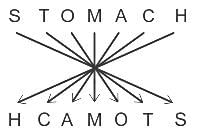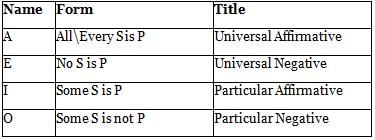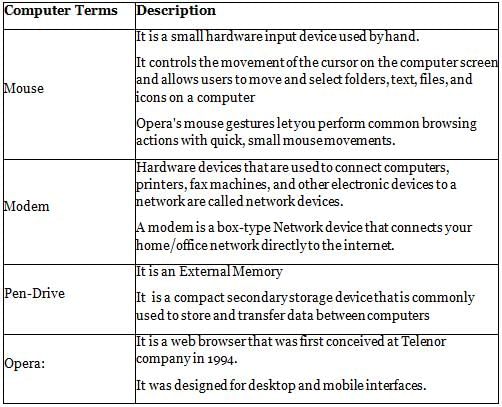MH SET Paper 1 Mock Test - 1 - MAHA TET MCQ
30 Questions MCQ Test - MH SET Paper 1 Mock Test - 1
The population information is called parameter while the corresponding sample information is known as
Directions: Read the given passage carefully and answer the following question:
Heritage conservation practices improved worldwide after the International Centre for the Study of the Preservation and Restoration of Cultural Property (ICCROM) was established with UNESCO’s assistance in 1959. The inter-governmental organisation with 126 member states has done a commendable job by training more than 4,000 professionals, providing practice standards, and sharing technical expertise. In this golden jubilee year, as we acknowledge its key role in global conservation, an assessment of international practices would be meaningful to the Indian conservation movement. Consistent investment, rigorous attention, and dedicated research and dissemination are some of the positive lessons to imbibe. Countries such as Italy have demonstrated that prioritising heritage with significant budget provision pays. On the other hand, India, which is no less endowed in terms of cultural capital, has a long way to go. Surveys indicate that in addition to the 6,600 protected monuments, there are over 60,000 equally valuable heritage structures that await attention. Besides the small group in the service of Archaeological Survey of India, there are only about 150 trained conservation professionals. In order to overcome this severe shortage, the emphasis has been on setting up dedicated labs and training institutions. It would make much better sense for conservation to be made part of mainstream research and engineering institutes, as has been done in Europe.
Increasing funding and building institutions are the relatively easy part. The real challenge is to redefine international approaches to address local contexts. Conservation cannot limit itself to enhancing the art-historical value of the heritage structures, which international charters perhaps overemphasise. The effort has to be broad-based: It must also serve as a means to improving the quality of life in the area where the heritage structures are located. The first task, therefore, is to integrate conservation efforts with sound development plans that take care of people living in the heritage vicinity. Unlike in western countries, many traditional building crafts survive in India, and conservation practices offer an avenue to support them. This has been acknowledged by the Indian National Trust for Art and Cultural Heritage charter for conservation but is yet to receive substantial state support. More strength for heritage conservation can be mobilised by aligning it with the green building movement. Heritage structures are essentially eco-friendly and conservation could become a vital part of the sustainable building practices campaign in future.
Q. The inter-government organisation was appreciated because of
Heritage conservation practices improved worldwide after the International Centre for the Study of the Preservation and Restoration of Cultural Property (ICCROM) was established with UNESCO’s assistance in 1959. The inter-governmental organisation with 126 member states has done a commendable job by training more than 4,000 professionals, providing practice standards, and sharing technical expertise. In this golden jubilee year, as we acknowledge its key role in global conservation, an assessment of international practices would be meaningful to the Indian conservation movement. Consistent investment, rigorous attention, and dedicated research and dissemination are some of the positive lessons to imbibe. Countries such as Italy have demonstrated that prioritising heritage with significant budget provision pays. On the other hand, India, which is no less endowed in terms of cultural capital, has a long way to go. Surveys indicate that in addition to the 6,600 protected monuments, there are over 60,000 equally valuable heritage structures that await attention. Besides the small group in the service of Archaeological Survey of India, there are only about 150 trained conservation professionals. In order to overcome this severe shortage, the emphasis has been on setting up dedicated labs and training institutions. It would make much better sense for conservation to be made part of mainstream research and engineering institutes, as has been done in Europe.
Increasing funding and building institutions are the relatively easy part. The real challenge is to redefine international approaches to address local contexts. Conservation cannot limit itself to enhancing the art-historical value of the heritage structures, which international charters perhaps overemphasise. The effort has to be broad-based: It must also serve as a means to improving the quality of life in the area where the heritage structures are located. The first task, therefore, is to integrate conservation efforts with sound development plans that take care of people living in the heritage vicinity. Unlike in western countries, many traditional building crafts survive in India, and conservation practices offer an avenue to support them. This has been acknowledged by the Indian National Trust for Art and Cultural Heritage charter for conservation but is yet to receive substantial state support. More strength for heritage conservation can be mobilised by aligning it with the green building movement. Heritage structures are essentially eco-friendly and conservation could become a vital part of the sustainable building practices campaign in future.
Environmental education should be taught in schools because
Which one of the following is a non-probability sampling?
Directions: Read the data given in the following bar-graph carefully and answer the following question.
The bar-graph shows the net profit of a multinational company ABC (in Cr) from 2001-2002 to 2008-2009.
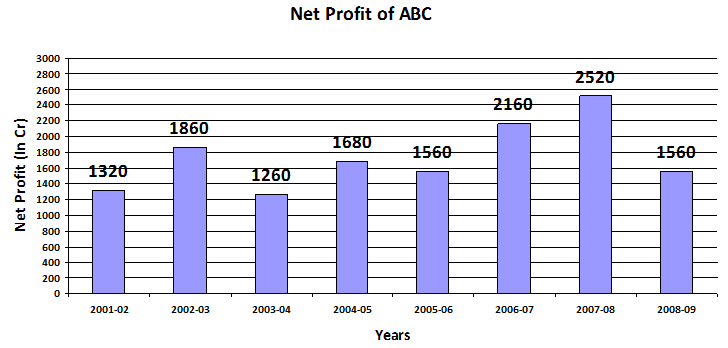
Q. If the company had predicted the net profit for the year 2003-04 after interpolating (linear) the profit from 2001-02 to 2002-03, what was their prediction?
Match List I with List II gives their characteristic features.
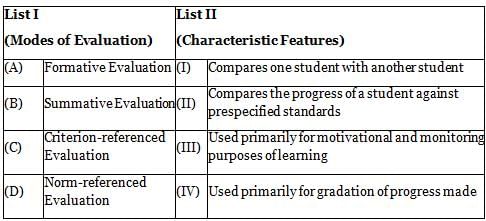
Choose the correct answer from the options given below :
Directions: Read the following passage carefully and answer the given question.
James adison said, "People who mean to be their own governors must arm themselves with power that knowledge gives." In India, the Official Secrets Act, 1923 was a convenient smokescreen to deny members of the public access to information. Public functioning has traditionally been shrouded in secrecy. But in a democracy in which people govern themselves, it is necessary to have more openness. In the maturing of our democracy, right to information is a major step forward; it enables citizens to participate fully in the decision-making process that affects their lives so profoundly. It is in this context that the address of the Prime Minister in the Lok Sabha is significant. He said, "I would only like to see that everyone, particularly our civil servants, should see the Bill in a positive spirit; not as a draconian law for paralysing Government, but as an instrument for improving Government-Citizen interface resulting in a friendly, caring and effective Government functioning for the good of our People." He further said, "This is an innovative Bill, where there will be scope to review its functioning as we gain experience. Therefore, this is a piece of legislation, whose working will be kept under constant reviews."
The Commission, in its Report, has dealt with the application of the Right to Information in Executive, Legislature and Judiciary. The Judiciary could be a pioneer in implementing the Act in letter and spirit because much of the work that the Judiciary does is open to public scrutiny. Government of India has sanctioned an e-governance project in the Judiciary for about Rs. 700 crore which would bring about systematic classification, standardisation and categorisation of records. This would help the Judiciary to fulfil its mandate under the Act. Similar capacity building would be required in all other public authorities. The transformation from non-transparency to transparency and public accountability is the responsibility of all three organs of the State.
Q. Right to Information is a major step forward to
Directions: Read the following passage carefully and answer the question.
The popular view of towns and cities in developing countries and of urbanisation process is that despite the benefits and comforts it brings, the emergence of such cities connotes environmental degradation, generation of slums and squatters, urban poverty, unemployment, crimes, lawlessness, traffic chaos etc. But what is the reality? Given the unprecedented increase in urban population over the last 50 years from 300 million in 1950 to 2 billion in 2000 in developing countries, the wonder really is how well the world has coped, and not how badly.
In general, the urban quality of life has improved in terms of availability of water and sanitation, power, health and education, communication and transport. By way of illustration, a large number of urban residents have been provided with improved water in urban areas in Asia’s largest countries such as China, India, Indonesia and Philippines. Despite that, the access to improved water in terms of percentage of total urban population seems to have declined during the last decade of 20th century, though in absolute numbers, millions of additional urbanites have been provided improved services. These countries have made significant progress in the provision of sanitation services too, together, providing for an additional population of more than 293 million citizens within a decade (1990-2000). These improvements must be viewed against the backdrop of rapidly increasing urban population, fiscal crunch and strained human resources and efficient and quality-oriented public management.
Q. Which of the following statements cannot be inferred from the given passage?
Which one of the following is considered a sign of motivated teaching?
Directions: Study the following information and answer the question that follows.
The percentage of employees in various departments in company A is as shown below.
There are 1800 employees in total.
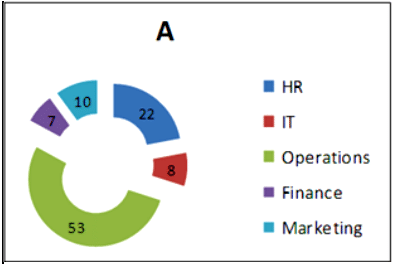
Q. If 30 more people join the Operations department, then what will be the percentage of employees in the Operations department?
The essential quality/qualities of a researcher is/are
Direction: Read the passage carefully and choose the best answer to each question out of the four alternatives.
It is not good manners to stop a person on the street or in a shop, or in the performance of any duty and to talk to him for ten, fifteen, or twenty minutes just to pass the time of day. We can tell that a person is in a hurry to get somewhere, or he is doing something, and we know enough not to interrupt him for any length of time. Yet some of us think nothing of calling someone on the telephone, interrupting him without a thought about what he may be doing, and chattering away, forgetting about time or anything else. Perhaps we don’t consider our telephone conversation an interruption because we don’t see what we have interrupted. Naturally, we must observe the common courtesies over the telephone. But we must remember that one of the courtesies of telephoning is to be brief.
Never ask anybody to guess who you are? The person you are telephoning may not be in a guessing mood. If you know him, you may want to ask after the state of his health and that of his family, but as soon as you possibly can, go get on with your business. He certainly wants to know why you are telephoning him. When you are finished with your business, you might take moment to observe the natural courtesies of conversation, expressing your thanks before ending your call.
From the way the telephone is used in your home, you would hardly suspect that this is an instrument on which very important business transactions are conducted. There are times when even you are called upon to be business-like, brief, and effective on the telephone.
Q. How can we make the best use of a telephone?
Directions: Study the given information and answer the following question.
The line graph shows the incentive points earned by four salespersons in different months of 2017.
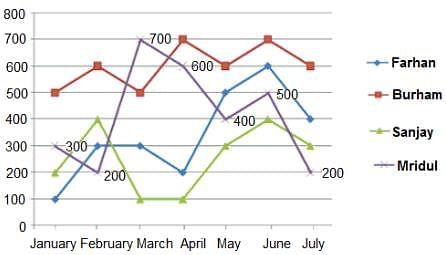
Q. Which salesperson(s) earned the second-highest points during the given period?
The South Asia University is situated in the city of
TEQIP (Technical Education Quality Improvement Programme) was launched by MHRD in which of the following years?
In a certain code language, 'STOMACH' is written as 'HCAMOTS'. How will 'PHONES' be written in that language?
Match List I with List II:
Consider the following in the context of the Square of Opposition of Propositions:

Choose the correct answer from the options given below:
If a researcher conducts a research on finding out which administrative style contributes more to institutional effectiveness, it will be an example of
Match List I with List II.
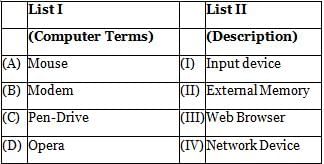
Choose the correct answer from the options given below:
Which of the following is not a source of pollution in soil?
Directions: Read the following passage carefully and answer the question.
The Taj Mahal has become one of the world’s best known monuments. This domed white marble structure is situated on a high plinth at the southern end of a four-quartered garden, evoking the gardens of paradise, enclosed within walls measuring 305 metres by 549 metres. Outside the walls, in an area known as Mumtazabad, were living quarters for attendants, markets, sarais and other structures built by local merchants and nobles. The tomb complex and the other imperial structures of Mumtazabad were maintained by the income of thirty villages given specifically for the tomb’s support. The name Taj Mahal is unknown in Mughal chronicles, but it is used by contemporary Europeans in India, suggesting that this was the tomb’s popular name. In contemporary texts, it is generally called simply the Illuminated Tomb (Rauza-i-Munavvara).
Mumtaz Mahal died shortly after delivering her fourteenth child in 1631. The Mughal court was then residing in Burhanpur. Her remains were temporarily buried by the grief-stricken emperor in a spacious garden known as Zainabad on the bank of the river Tapti. Six months later, her body was transported to Agra, where it was interred in land chosen for the mausoleum. This land, situated south of the Mughal city on the bank of the Jamuna, had belonged to the Kachhwaha rajas since the time of Raja Man Singh and was purchased from the then current raja, Jai Singh. Although contemporary chronicles indicate Jai Singh’s willing cooperation in this exchange, extant farmans (imperial commands) indicate that the final price was not settled until almost two years after the mausoleum’s commencement. Jai Singh’s further cooperation was insured by imperial orders issued between 1632 and 1637 demanding that he provide stone masons and carts to transport marble from the mines at Makrana, within his “ancestral domain”, to Agra where both the Taj Mahal and Shah Jahan’s additions to the Agra fort were constructed concurrently.
Work on the mausoleum was commenced early in 1632. Inscriptional evidence indicates much of the tomb was completed by 1636. By 1643, when Shah Jahan most lavishly celebrated the ‘Urs ceremony for Mumtaz Mahal’, the entire complex was virtually complete.
Q. The popular name Taj Mahal was given by
Direction: Following table shows the percentage distribution of votes amongst five candidates A, B, C, D and E and total votes cast (in hundred) during the year 2013 to 2018 of collage presidential election. Study the data carefully and answer the questions based on it.
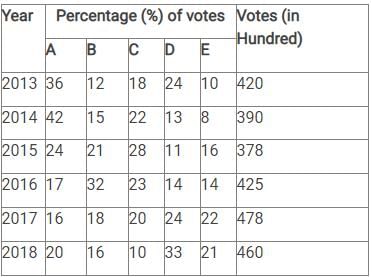
Q. What is the average number of votes a candidate gets in 2018?
Which of the following is true about the National Mission in Education through ICT (NMEICT)?
- It is a centrally sponsored scheme to enhance Gross Enrollment Ratio in higher education by making use of ICT.
- The two major components are providing access and content generation.
Which of the following school of philosophy accepts 'Sabda' as valid means of knowledge?
What is the basis on which assumptions are formulated?
Which of the following problems is related to classroom management?
A computer program that translates a program statement by statement into machine language is called a/an
A trader marks his goods 40% above the cost price and gives the discount of 20% on it. What is the profit percentage?



 = 954
= 954